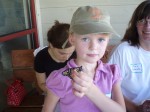Last January, a depressing article in the New York Times explained, “Faltering under extreme weather and vanishing habitats, the yearly winter migration of monarch butterflies to a handful of forested Mexican mountains dwindled precipitously in December, continuing what scientists said was an increasingly alarming decline.
“The migrating population has become so small — perhaps 35 million, experts guess — that the prospects of its rebounding to levels seen even five years ago are diminishing. At worst, scientists said, a migration widely called one of the world’s great natural spectacles is in danger of effectively vanishing.”
After seeing almost no monarchs at last year, in spite of the fact that Crossroads is full of milkweed (thanks to generations of kindergarten students who each fall help distribute the milkweed seeds by blowing the fluffy seeds from their pods.) But this summer, the striking black and orange butterflies, while not numerous, are at least common in the preserve.
As I was writing this, I had public radio on and Tom Ashbrook’s program, ON POINT came on with this introduction: “We love butterflies, and monarch butterflies are called “monarch” for a reason. They are grand. All that fluttering orange and black display on a winged scale built to impress. To charm. But monarch butterflies are in trouble. This year saw the smallest migration ever recorded to their winter retreat in the mountains of Mexico. And if you are looking this summer for monarchs, they’ve been hard to find. There’s a reason, and it goes back to genetically-modified crops, say my guests today.”
And the featured guest was none other than Lincoln Brower, who has conducted monarch research at Newport State Park for decades and is one of our most popular speakers at Crossroads. The other, Karen Oberhauser, is an associate professor in the department of fisheries, wildlife and conservation biology at the University of Minnesota but she was speaking from Shawano (which, predictably, host Tom Ashbrook pronounced wrong. He’s not from Wisconsin.)
Both experts blamed loss of habitat as the cause for the Monarch decline, and by that, they meant both loss of milkweed plants which as absolutely necessary for reproduction and nectar sources–the flower on which adult butterflies feed during their journey to Mexico.
The Monarch see in the summer really do not live very long…somewhere between two and six weeks. These butterflies will not fly to Mexico. But they will mate and lay eggs. That’s what adult insects do. Except in the case of Monarchs, the adult butterflies that emerge in late summer, do not have any desire to mate. Instead, they are instinctively compelled to drink nectar from as many flowers as possible. The have to build up fat reserves. They need to have enough fat to fly from here to Mexico, to live through winter, and then to mate a start the journey north next spring.
You’d think they’d use up all of their fat by flying to Mexico, but you would be wrong. Butterflies actually gain weight on the journey south because they glide most of the trip, but they also “refuel” with nectar along the way….IF they can find flowers. And that is part of the problem.
As Dr. Brower explained, the agricultural areas of the Midwest are essentially a sterilized landscape because herbicides have decimated the “weeds” which means the Monarch food source is wiped out.
Brower refers to the Monarch as a “butterfly in the coal mine”—a serious warning of impending disaster— because, ironically, insect pollinators are absolutely necessary for a number of agricultural crops.
This is why places like Crossroads, like Door County preserves and parks, and private lands and even gardens are extremely valuable, because they form a botanical bridge between Monarch breeding areas and their winter homes in Mexico.
We know that the butterflies we find at Crossroads at the end of August and in September do go to Mexico, because several years ago, a tagged Monarch was found in the wintering site. A young person tagged the butterfly during a Crossroads program.
And on Sunday, August 31 at 1:00, thanks to the North east Wisconsin Audubon Society which annually sponsors this program, Ann Shebesta, ‘the Monarch Lady of Mishicot” will return to Crossroads with her lively program for learners of all ages. After an indoor introduction on the Monarch life cycle, she will hand out nest to see how many butterflies we can catch and tag. Participants are encouraged to bring home-reared monarchs for tagging and. may want to have a camera handy for the “Monarch in Hand” photo op!
east Wisconsin Audubon Society which annually sponsors this program, Ann Shebesta, ‘the Monarch Lady of Mishicot” will return to Crossroads with her lively program for learners of all ages. After an indoor introduction on the Monarch life cycle, she will hand out nest to see how many butterflies we can catch and tag. Participants are encouraged to bring home-reared monarchs for tagging and. may want to have a camera handy for the “Monarch in Hand” photo op!
And when that program is over, there will still be a much to do because at 2:00, the Door County Historical Society will have a whole array of activities going on at the Heritage Village at Big Creek. The Cherryland ‘A’s, Modal A Club will have their restored cars on display, the Blacksmiths will demonstrate their skills (and will be happy to sell you their products) and an Ice Cream Social will top off the activities.


